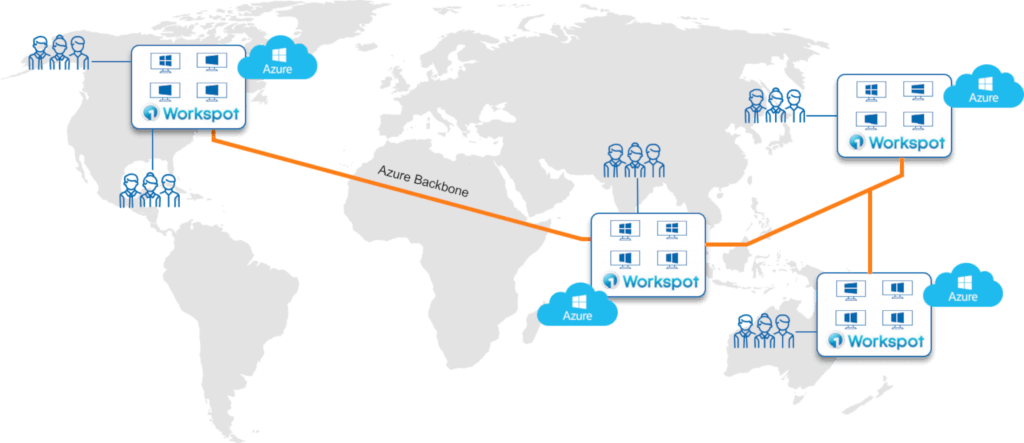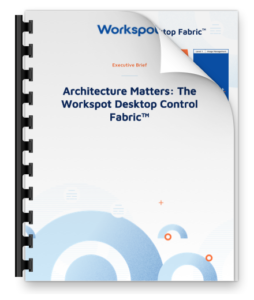Top 3 Reasons Why You Need Multi-Region Cloud Desktops
It’s one thing to have a multi-cloud strategy. We hear about that all the time, and there are numerous reasons why enterprises will play to the strengths of different clouds, but a multi-region strategy is a whole different ballgame. In case there is any doubt about why you need one, let’s take a closer look at what it means, and why it’s massively important to your success if you’re evaluating cloud desktop solutions.
Desktops Are On The Move
We are seeing tremendous momentum to move desktop workloads to the cloud. For many organizations, there has been pent-up demand for virtual desktops because the cost and complexity of legacy VDI solutions kept them out of the game. They have been stuck with inflexible physical PCs and workstations that have to be constantly maintained and refreshed every few years. In many other cases, IT teams struggled with on-prem VDI and made the best of it. Still other organizations have tried one of the newer cloud desktop solutions, only to find that they couldn’t get a real Windows 10 desktop (only a Windows 10 “experience’) or that they still had to buy and maintain a bunch of infrastructure for their cloud solution. Hmmm.
The conversations we are having with customers and prospects today are all about business agility, user experience and possibilities for growth. If the virtual desktop vendor you’re talking with can’t meet or exceed your expectations in those areas, you’re on the wrong path. Here’s why.
It’s 8 am; Do You Know Where Your PC Is?
Why Multi-Region Cloud Desktops? Reason #1: Blazing fast performance that fuels productivity.
If you use a laptop or desktop PC, you know exactly where it is at all times. It’s in close proximity to where you are. Makes sense, right? Because that’s the only way you can use it. If you’re using a virtual desktop, chances are it’s an on-prem solution. Where is that desktop? It’s in the data center. And where is the user of that desktop? Could be close to the data center. Could be at home which might be a little or a lot farther away from the data center. Could be halfway across the world in Morrocco, which is probably really, really far away from the data center. Users may or may not have a sense of this proximity, but when in Morrocco, or anywhere that is more than 50ms away from the data center, latency is going to impact performance, and at over 150ms it’s going to be a performance (and productivity) killer. Users might tolerate it; after all, they have more time to chat with coworkers, but that doesn’t seem great for productivity. IT teams feel this pain too because they make up the grievance committee; they hear all the complaints about poor performance of virtual desktops, and they are on the front lines of all the maintenance and troubleshooting that has to happen to micro-manage reliability. So how do you make sure that your virtual desktop is close by, so latency is a non-issue? How do you keep users happy and productive with blazing fast performance? You put their cloud desktops in the Azure regions close to them. How can power users with GPU-intensive apps finally get to work remotely, whether at home or a client site? You put their cloud workstations in the Azure region closest to them and give them a low-cost device to access it. Seriously. There are thousands of CAD users around the globe using Workspot cloud workstations today and loving them. To keep them close, just place all your users’ cloud desktops and workstations in one of the 56+ Microsoft Azure regions around the world.
We cover this scenario with customers all the time and they love it because it provides a more predictable, PC-like experience vs. an unpredictable legacy VDI experience. However, inevitably prudent customers ask: What if my applications or data are not in the same local region as the desktop? Won’t that increase latency elsewhere and impact the experience? It’s a great question. What we have found is that compared to connecting over unreliable WAN circuits, including SDWAN, performance is improved by delivering the experience over the high-bandwidth and very reliable Azure backbone. Additionally, just as you’d be close to a PC, in most cases you will likely be close to your desktop region and can easily experiment for optimal placement. We have found that in most customer use cases, data latency impact is considerably less than screen latency performance. This is why placing the desktops in Azure cloud regions close to your end users provides great performance vs. traditional approaches of using 2-3 enterprise data centers that introduce screen latency. For the sub-set of applications that may be data-latency sensitive, our customer may decide to use published applications alongside their cloud desktops. The bottom line? Now there is so much more flexibility for meeting enterprise requirements! It starts with a multi-region cloud architecture.
Who Has What Data On Which Device, Where?
Why Multi-Region Cloud Desktops? Reason #2: Security & visibility
People want the option of working remotely using their devices of choice. However, remote work not only has performance implications (see Reason #1), it also has huge implications for security, and for the ability of IT to be able to monitor what’s happening. When you make the decision to use Workspot for delivering cloud desktops and workstations from Azure, you’re also fortifying your company’s security posture and reducing risk. That’s because you get a double dose of security that is inherent to Workspot cloud desktops: Workspot’s unique architecture that never allows your data to pass through the VDI control plane and support for multi-factor authentication, plus the vast investments Microsoft has made in Azure security. You might as well face the fact that it’s unlikely your in-house IT team can pull off that same level of data security with physical desktops or on-prem VDI. With a multi-region cloud desktop solution, data stays secure in Azure, users access apps and data securely from anywhere, using whatever device they feel like using, and IT teams use a single pane of glass to monitor everything, globally, across cloud regions. Only Workspot can support multi-region cloud desktops this way!
Why Choose Tech That Limits Business Growth?
Why Multi-Region Cloud Desktops? Reason #3: Business agility that drives growth
If you’re choosing technology solutions that are inflexible, difficult to scale, or can’t roll with changing business dynamics, it’s going to come back to bite you. Trying to grow a business is not easy, and you need every advantage to do it. Every day we have conversations with prospects and customers about agility. The only way to achieve game-changing agility that drives growth? You must be able to quickly and easily scale up, both vertically (add tens, hundreds or thousands of users) and horizontally (deploy more desktops and workstations across cloud regions, globally). When you have this capability, you can add cloud desktops and workstations in minutes. You can hire the best people no matter where they live because they can work anywhere – at home, or in shared office space. You can’t achieve any of these things with on-prem VDI, other cloud desktop solutions, or physical PCs. Those solutions actually limit the possibilities for your business.
Ask vendors two key questions: Can you deploy cloud desktops and workstations within 25ms of all my users? How long it will take? Let the answers be your guiding light to Workspot on Azure!

To learn more about Workspot innovation read the blog What is the Cloud Desktop Fabric?
Ready to learn more? Schedule a demo now.



